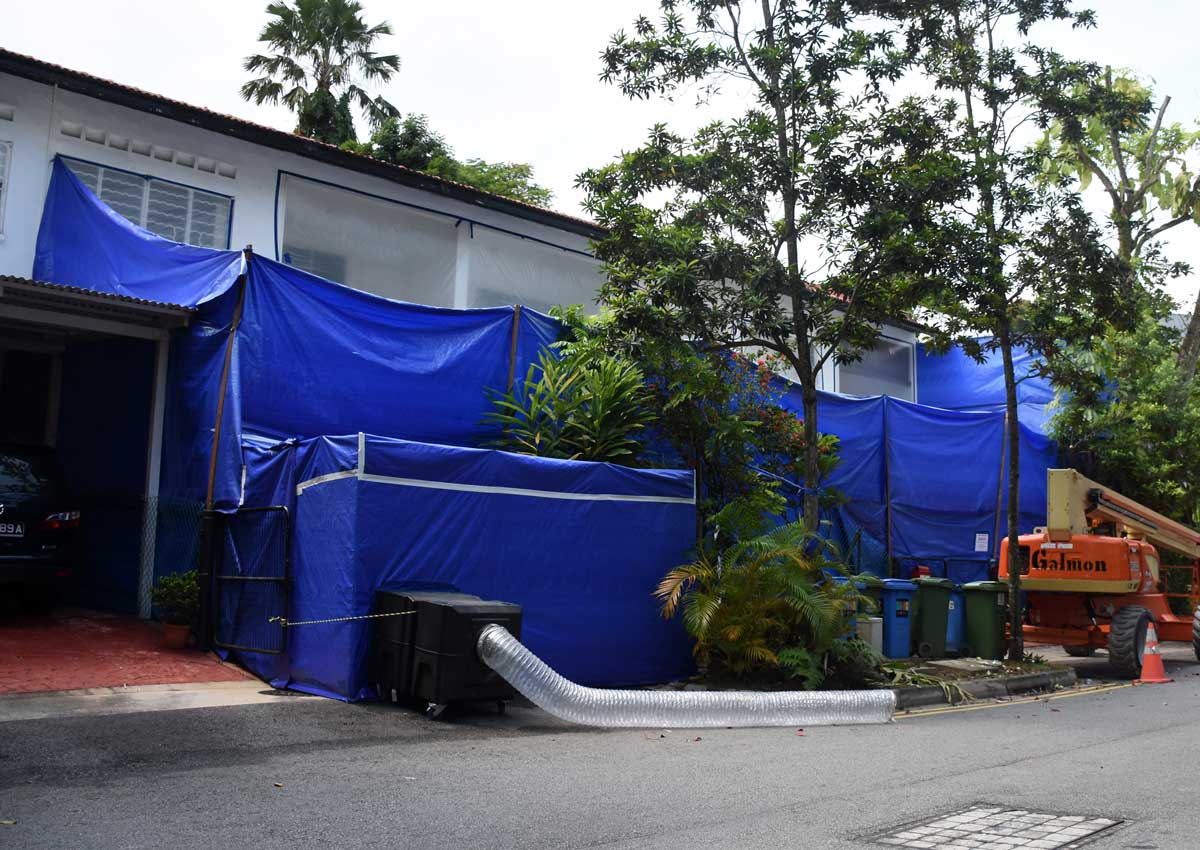The corrugated roof sheets of terraced houses in Chip Bee Gardens are being replaced after asbestos was found in some of them.
This has unsettled some residents in the private housing estate beside Holland Village who fear that their roof sheets, or awnings, might be unsafe.
Asbestos, once a popular component in building materials, is linked to health problems such as lung cancer. Its use in buildings was banned here in 1989, but many earlier structures still contain the substance.
While the 349 state-owned black- and-white terraced houses in Chip Bee Gardens were built in the 1960s, the use of asbestos there was uncovered only earlier this year, The Straits Times has learnt.
The Singapore Land Authority (SLA), custodian of state-owned properties, said this happened on April 26, when a contractor who was inspecting a broken roof above the front porch of a vacant house in Jalan Puteh Jerneh noticed that the material could contain asbestos. The porch roof was removed on April 29 and replaced on May 3. Laboratory tests revealed that it contained chrysotile, a common type of asbestos.
Tests done on two other houses in the neighbourhood also uncovered asbestos in their front roof sheets, the SLA said. Several residents met the SLA on May 17.
Housewife Essa Tay, 34, who lives across from the house with the broken porch roof, said: “I feel uncomfortable. I’m especially worried because I have a two-year-old daughter and I’m pregnant.”
Citing the Ministry of Manpower (MOM), which regulates asbestos removal here, the SLA said roof awnings are not likely to pose any health risk to occupants if they are intact. But if they are disturbed, asbestos fibres could become airborne.
As an interim measure, an asbestos specialist hired by the SLA will visually inspect 323 terraced houses with corrugated roof sheets in the estate over the next few weeks.
The remaining 26 units are not affected as they have clay-tiled porch roofs that do not contain asbestos.
Depending on their condition, the roof sheets will be left alone, coated with a sealant, or replaced.
So far, the SLA’s asbestos specialist has inspected the awnings of 110 houses in the estate.
About a tenth of them were found to be in good condition, while 20 per cent are substantially damaged and require removal. The remaining 70 per cent have some cracks and damage and will be coated with a sealant.
“Should repairs or replacements be needed, they will be carried out promptly and safely by our asbestos specialists and in accordance with MOM guidelines,” said the SLA.
Under the guidelines, such work has to be carried out by an approved asbestos removal contractor. The work area must be enclosed to prevent the asbestos from spreading.
The SLA said that as tenants have to move out during the replacement of awnings, which takes about two to three days per unit, rent will be waived for that period.
When The Straits Times visited the estate last week, three houses in Jalan Hitam Manis were enclosed in sheets for asbestos removal.
Mr Lee Seng Lai, director of the SLA’s land operations (private) division, said that as a precaution, the SLA plans to replace all affected roof awnings in the estate within the next 18 months through a tendered project. “We have explained the situation to the tenants and will continue to keep them informed of the progress with the ongoing works.”
There were more than 250 cases of asbestos removal here last year, with about 200 cases on average each year, MOM figures show.
Some residents want their roofs to be replaced sooner and want better compensation for having to vacate during the asbestos removal.
Others are less troubled. A 40- year-old Jalan Hitam Manis resident from New York said: “I was born in the 1970s, when asbestos was alive and kicking. I don’t think of it as a problem. I’ll be worried when they start ripping the roofs out and replacing them. That’s when it’s dangerous.”
The SLA said that, in consultation with the MOM, residents may remain in their houses while asbestos removal is under way next door as measures are taken to prevent the spread of asbestos.
But Chip Bee resident and hedge- fund director Ian Seow, 37, said: “Going by the book is one thing, but this is an issue of health. We don’t want to take any chances.”

This article was first published on Jun 07, 2016.
Get a copy of The Straits Times or go to straitstimes.com for more stories.






